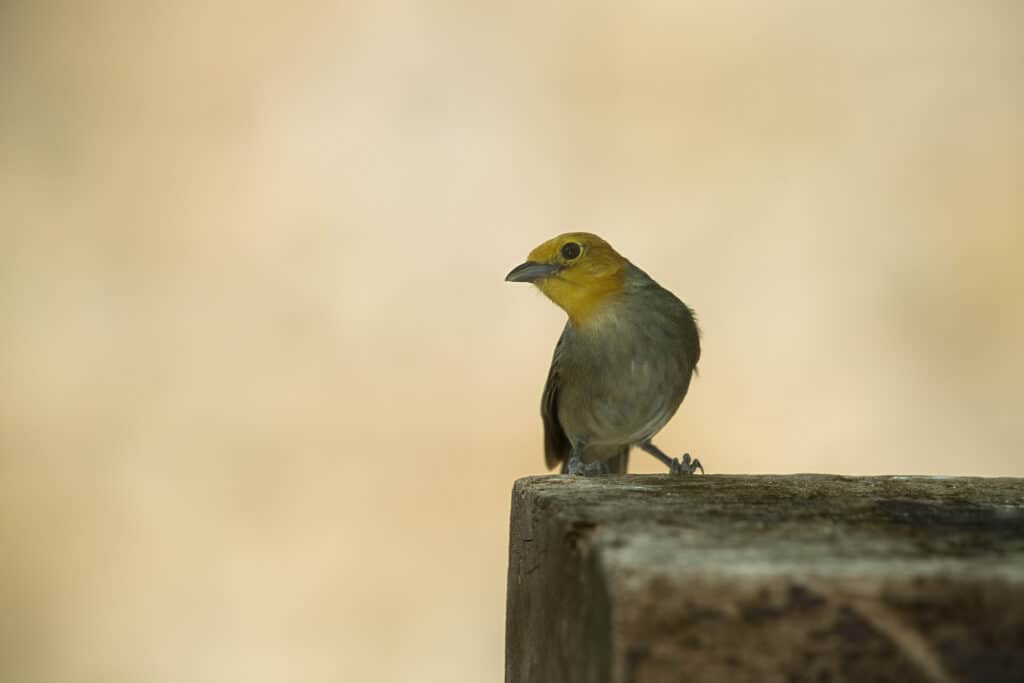They inhabit the lowlands of the Amazon rainforest
Advertisement
Orange Tanager (Orange-Headed Tanager) Scientific Classification
- Kingdom
- Animalia
- Phylum
- Chordata
- Class
- Aves
- Order
- Passeriformes
- Family
- Thraupidae
- Genus
- Thylpopsis
- Scientific Name
- Thlypopsis sordida
Read our Complete Guide to Classification of Animals.
Orange Tanager (Orange-Headed Tanager) Conservation Status
Orange Tanager (Orange-Headed Tanager) Facts
- Prey
- Grasshoppers, crickets, and locusts
- Main Prey
- Orthopterans
- Name Of Young
- Chicks
- Group Behavior
- Group
- Pair
- Fun Fact
- They inhabit the lowlands of the Amazon rainforest
- Estimated Population Size
- Unknown but stable
- Most Distinctive Feature
- Orange and yellow heads
- Distinctive Feature
- rotund bodies, thin bills, and medium-sized tails
- Habitat
- Semi-humid savannas and open woodlands
- Predators
- Birds of prey, monkeys, and snakes
- Diet
- Omnivore
- Lifestyle
- Diurnal
- Favorite Food
- Grasshoppers
- Type
- Bird
- Common Name
- Orange-headed tanager
- Special Features
- rapid, high-pitched calls
- Number Of Species
- 3
- Location
- South America
- Average Clutch Size
- 2
- Nesting Location
- Tree fork surrounded by vegetation
View all of the Orange Tanager (Orange-Headed Tanager) images!
“It lives in the lowlands of the Amazon rainforest.”
Summary
The orange tanager (orange-headed tanager) is a small bird native to the neotropical region of South America. It spends its days foraging in trees and shrubs for insects, often with a small group. Though relatively uncommon, they have an extensive range and learn to adapt to disruptions in their environment. Discover everything there is to know about this orange bird, including its habitat, diet, and behavior.
5 Amazing Orange Tanager Facts
- Orange tanagers inhabit the lowlands of the Amazon rainforest, living in semi-humid savannas and open woodlands.
- They make quick, high-pitched calls while perched on branches or in mid-flight.
- These birds are moderately social, often seen in pairs, small groups, or mixed-species flocks.
- They primarily eat orthopterans, which include crickets, grasshoppers, and locusts.
- This tanager species is largely unstudied. We don’t know much about its behavior, reproduction, and lifespan.
Where to Find the Orange Tanager
The orange tanager lives in eight countries in South America, including Argentina, Bolivia, Brazil, Colombia, Ecuador, Paraguay, Peru, and Venezuela. It inhabits the lowland areas of the Amazon rainforest but can be found in elevations up to 2,600 feet. It lives in semi-humid savannas, open woodlands, parks, and riparian forests in the Southern Amazon. You can find it in scrub, brush, and open woodland edges in Argentina. They will also inhabit heavily degraded former forests, but rarely in uninterrupted forests.
Orange Tanager Nest
Females place their nests in trees around six feet above the ground, most likely in a fork with plenty of vegetation. She makes a cup-shaped nest from twigs and other plant material.
Scientific Name
The orange tanager (Thlypopsis sordida) is from the Thraupidae family, which encompasses a large portion of neotropical perching birds. Its genus, Thlypopsis, included eight tanager species, of which the orange-headed tanager is the type species. It’s Ancient Greek for an unknown small bird. Its specific name, Sordida, is Latin for “dirty” or “shabby.” The orange tanager has three recognized subspecies.
Size, Appearance, & Behavior

Orange tanagers may not mate for life, but they most likely keep one mate per breeding season.
©Elkin Restrepo/Shutterstock.com
This small tanager measures 5.1 inches and weighs 0.49 to 0.67 ounces, with an unknown wingspan. Adult males have orangish-yellow heads with buff to white underparts and sandy-gray upper parts. And females and immatures have duller undersides and less extensive yellow coloring on their heads. This species also has small, thin bills, rotund bodies, and medium-sized tails. The orange tanager is moderately social, often found in pairs or small groups of three or four. They sometimes forage in mixed-species flocks. They glean for insects in trees, and you can hear their rapid, high-pitched calls while perched on a branch or mid-flight.
Migration Pattern and Timing
This species is primarily sedentary, but some populations in Brazil and Argentina will migrate short distances. Those living in the Andes Mountains will move to the lowlands during winter.
Diet
The orange tanager is an omnivore that forages like a warbler.
What Does the Orange Tanager Eat?
Their primary diet includes orthopterans, including grasshoppers, crickets, and locusts. But they also eat spiders, beetles, and flies. They supplement their diet with some fruit and seeds. They forage like New World warblers by hopping and gleaning insects from leaves and other foliage. Occasionally, they will snatch their prey mid-air.
Predators, Threats, and Conservation Status
The IUCN lists the orang tanager (orange-headed tanager) as LC or “least concern.” Due to its extensive range and stable population size, they do not meet the thresholds for “threatened” status. They are known for inhabiting heavily degraded former forests and adapting well to forest clearing.
What Eats the Orange Tanager?
Not much is known about the orange tanager’s predators, but they may include birds of prey like owls and falcons. Their nest predators are probably similar to other tanagers and include monkeys, snakes, and bigger carnivorous birds. Most tanagers make alarm sounds, chase, dive, and swoop at intruders.
Reproduction, Young, and Molting
Orange tanagers may not mate for life, but they most likely keep one mate per breeding season. The nesting season is in December, and females lay two bluish-white eggs with brown markings. The shiny cowbird occasionally lays its eggs in tanager nests. We don’t know how long the incubation process is or when their young fledge the nest. Orange tanagers live an average of 3.7 years.
Population
The orange tanager global population is unknown, but their numbers appear stable. Because their numbers have not been quantified, we can’t be sure they are not facing declines. This species is relatively common within its range and is not experiencing extreme fluctuations or fragmentations.
Similar Animals:
View all 66 animals that start with OOrange Tanager (Orange-Headed Tanager) FAQs (Frequently Asked Questions)
Where do orange tanagers live?
They live in semi-humid savannas and open woodlands in South America.
How big is an orange tanager?
This small tanager measures 5.1 inches and weighs 0.49 to 0.67 ounces, with an unknown wingspan.
What do orange tanagers look like?
Adult males have orangish-yellow heads with buff to white underparts and sandy-gray upper parts. And females and immatures have duller undersides and less extensive yellow coloring on their heads.
What do orange tanagers eat?
Their primary diet includes orthopterans, including grasshoppers, crickets, and locusts. But they also eat spiders, beetles, and flies.
What threatens the orange tanager?
Orange tanagers are facing any significant threats at the moment. They are known for inhabiting heavily degraded former forests and adapting well to forest clearing.
What eats orange tanagers?
These birds fall victim to birds of prey. Their nest predators include snakes, monkeys, and large birds.
How many eggs do orange tanagers lay?
Females lay two bluish-white eggs with brown markings.
Thank you for reading! Have some feedback for us? Contact the AZ Animals editorial team.
Sources
- Red List / BirdLife International, Available here: https://www.iucnredlist.org/species/22722263/94757935
- Peru Aves / A. Begazo, Available here: https://www.peruaves.org/thraupidae/orange-headed-tanager-thlypopsis-sordida/
- Avibase - The World Bird Database, Available here: https://avibase.bsc-eoc.org/species.jsp?lang=EN&avibaseid=B185095D38AFD28B&sec=summary

















